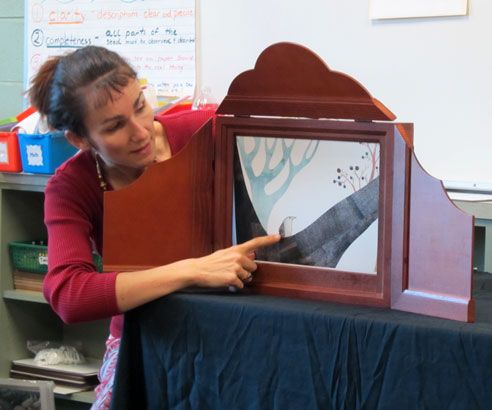

Kamishibai - Japanese Storytelling
Source/Author: Raffi Darrow, Ebytes Editor
April 07, 2016
Kamishibai (kah-mee-she-bye), or "paper-theater," started in Japan in the late 1920s, and is part of a long tradition of picture storytelling, beginning as early as the 9th or 10th centuries when priests used illustrated scrolls combined with narration to convey Buddhist doctrine to lay audiences. Because stories travel easily, Japanese storytelling was akin to street theatre. People would gather on the street and see illustrated cards slid into slots of wooden stages built on the back of bicycles, and the storyteller provided the necessary narration. Kamishibai is often seen as a precursor of manga and anime, and its influence can still be felt in the distinguishing features of these later media. There are Japanese kamishibai artists who have taken their art form to other parts of Asia, where people are learning to make and perform their own stories in their own languages. Now you can find Kamishibai stories in many languages including English, Spanish, French and even Turkish.
Shorecrest mom Karine Sabourault, aka “Ms. Kamishibai”, visited Lower School during Reading Week to share this Japanese storytelling artform with our students. She first witnessed the technique while living in China, and travelled to Japan to learn firsthand. There she procured her “magic box,” the stage that holds the drawings for each story. The drawings contain no words and have bits of the story written on the back, only for the storyteller to see. This allows the storyteller more freedom to elaborate, skip around, tailor a story to the audience, or focus on specific visual elements within the images. Kamishibai have also been used to teach foreign languages, math, marketing and other concepts.
Traditionally, the "kamishibai man" was a candy seller as well as a storyteller. He would enter a village or a neighborhood loudly clapping together two wooden blocks. This was the signal for the young children to come from their homes to gather around him for a kamishibai performance. First, he would sell candy, and those who bought some received the best seats. Although our students were not given candy, Ms. Kamishibai did begin each story by clapping together two blocks. This easily silenced the crowd, and students were enraptured as she opened her “magic box” and began telling the story corresponding to the beautiful drawings inside.
After sharing 2 stories, Ms. Kamishibai gave some of the history of the artform, shared some of her technique tips, and answered questions the students had.
"Storytelling is a powerful way to immerse oneself into the culture of a country," says Lower School Media Specialist Dottie Smay. "Students and teachers loved this style of storytelling, and some of the children asked for Japanese stories when they visited the library this week. I always tell the students to listen to the stories they hear from their parents and grandparents, since sometimes those stories are better than the ones they will find in books. In this day with so much technology, it is refreshing to know that sometimes it is great to unplug and listen to a storyteller."
(Watch a clip here.)
"Storytelling is a powerful way to immerse oneself into the culture of a country," says Lower School Media Specialist Dottie Smay. "Students and teachers loved this style of storytelling, and some of the children asked for Japanese stories when they visited the library this week. I always tell the students to listen to the stories they hear from their parents and grandparents, since sometimes those stories are better than the ones they will find in books. In this day with so much technology, it is refreshing to know that sometimes it is great to unplug and listen to a storyteller."
(Watch a clip here.)
























